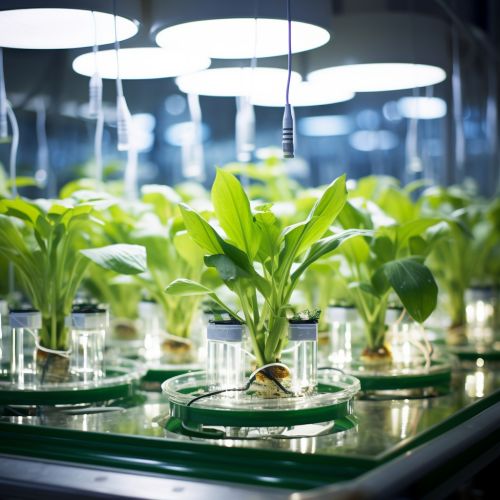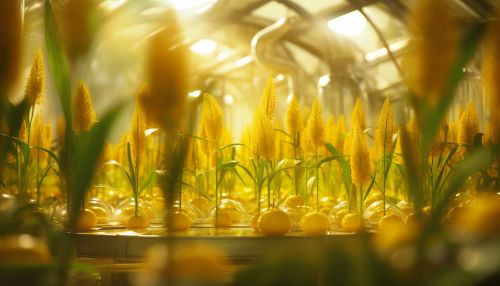The Role of Gene Editing in Enhancing Nutritional Quality of Crops
Introduction
Gene editing, a revolutionary technique in the field of genetics, has been increasingly used in crop improvement to enhance nutritional quality. This article delves into the role of gene editing in enhancing the nutritional quality of crops, the techniques involved, the benefits and challenges, and the ethical and regulatory considerations.


Gene Editing Techniques
CRISPR-Cas9
The CRISPR-Cas9 system is a powerful tool for gene editing in crops. It allows for precise, targeted changes to the genetic material of a plant, enabling scientists to enhance the nutritional content of crops. The system works by introducing a guide RNA sequence into a plant cell, which directs the Cas9 enzyme to a specific location in the plant's genome. The Cas9 enzyme then makes a cut at that location, allowing for the insertion, deletion, or modification of genes.
TALENs and ZFNs
Transcription Activator-Like Effector Nucleases (TALENs) and Zinc Finger Nucleases (ZFNs) are other gene editing tools used in crop improvement. Like CRISPR-Cas9, these tools allow for targeted changes to a plant's genome, but they work in slightly different ways. TALENs and ZFNs recognize and bind to specific DNA sequences, and then introduce breaks in the DNA at those locations. This allows for the insertion, deletion, or modification of genes.
Enhancing Nutritional Quality
Gene editing can be used to enhance the nutritional quality of crops in several ways. For example, it can be used to increase the levels of essential vitamins and minerals in crops, to improve the quality of proteins and fats, and to reduce the levels of anti-nutritional factors.
Increasing Vitamins and Minerals
Gene editing can be used to increase the levels of essential vitamins and minerals in crops. For example, the Golden Rice project used gene editing to increase the levels of vitamin A in rice, a staple food for many people in developing countries who suffer from vitamin A deficiency.
Improving Protein and Fat Quality
Gene editing can also be used to improve the quality of proteins and fats in crops. For example, it can be used to increase the levels of essential amino acids in crops, which are the building blocks of proteins. It can also be used to modify the types of fats in crops, for example, by increasing the levels of healthy unsaturated fats and reducing the levels of unhealthy saturated fats.
Reducing Anti-Nutritional Factors
Some crops contain substances known as anti-nutritional factors, which can interfere with the absorption of nutrients. Gene editing can be used to reduce the levels of these anti-nutritional factors, thereby improving the nutritional quality of the crops.
Benefits and Challenges
Gene editing offers many benefits for enhancing the nutritional quality of crops. It allows for precise, targeted changes to a plant's genome, which can result in improved nutritional content. However, there are also challenges associated with gene editing, including technical challenges, regulatory hurdles, and public acceptance issues.
Benefits
The main benefit of gene editing is that it allows for precise, targeted changes to a plant's genome. This can result in improved nutritional content, as well as other benefits such as increased yield and resistance to pests and diseases.
Challenges
Despite the many benefits of gene editing, there are also challenges associated with its use. These include technical challenges, such as the need for high levels of precision and accuracy in the gene editing process. There are also regulatory hurdles, as gene edited crops are subject to strict regulations in many countries. Finally, there are issues related to public acceptance, as some people have concerns about the safety and ethics of gene editing.
Ethical and Regulatory Considerations
The use of gene editing in crop improvement raises a number of ethical and regulatory considerations. These include issues related to safety, equity, and the potential for unintended consequences.
Safety
One of the main ethical considerations is the safety of gene edited crops. While gene editing allows for precise changes to a plant's genome, there is still the potential for off-target effects, where changes occur in unintended locations in the genome. This could potentially result in unintended consequences, such as the creation of new allergens.
Equity
Another ethical consideration is the issue of equity. There is concern that the benefits of gene edited crops may not be equally distributed, and that they may primarily benefit large agricultural companies at the expense of small farmers.
Regulation
The regulation of gene edited crops is a complex issue. In some countries, gene edited crops are subject to the same regulations as genetically modified (GM) crops, while in others they are regulated differently. This can create challenges for the development and commercialization of gene edited crops.
Conclusion
Gene editing is a powerful tool for enhancing the nutritional quality of crops. It offers many benefits, including the ability to make precise, targeted changes to a plant's genome. However, there are also challenges associated with its use, including technical challenges, regulatory hurdles, and public acceptance issues. Furthermore, the use of gene editing in crop improvement raises a number of ethical and regulatory considerations, including issues related to safety, equity, and the potential for unintended consequences.
